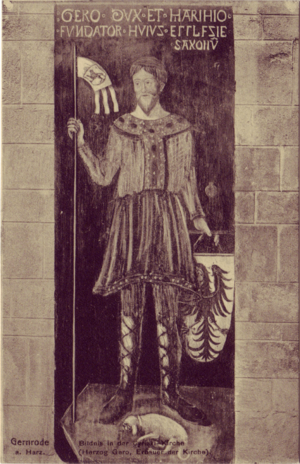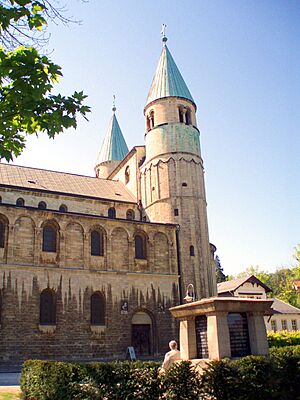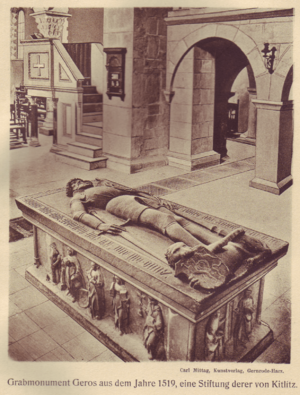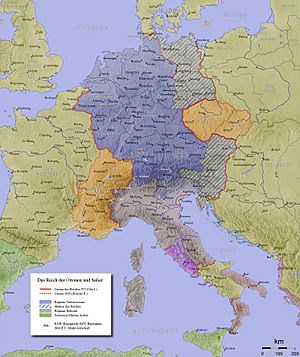Gero facts for kids
Gero I (born around c. 900 – died May 20, 965), also known as Gero the Great, was a powerful German nobleman. He started out ruling a small border area called a march near Merseburg in what is now Saxony-Anhalt, Germany. He managed to expand this territory into a huge region that was even named after him: the marca Geronis. In the mid-900s, he was a key leader in the Saxon expansion eastward.
Contents
Becoming a Leader
Gero was the son of Count Thietmar. In 937, King Otto of Saxony chose Gero to take over from his brother, Siegfried. Gero became a count and a margrave, which meant he was a powerful ruler in a border region facing the Wends, a group of Slavic people.
This decision made some people unhappy, especially Thankmar, the king's half-brother. Thankmar, along with others, rebelled against King Otto in 938. However, Thankmar died within a year, and the rebellion ended. Gero was able to keep his important position.
During this time, Gero was also fighting against the Slavs. His army faced difficulties, and the Slavs refused to pay tribute. Gero had a special group of elite fighters, sometimes called a "warband," who were very skilled and important to his military power.
Battles and Expansion
In 939, a group called the Obodrites attacked, defeating a Saxon army. To get revenge, Gero invited thirty Slavic leaders to a feast and killed almost all of them. This led to a revolt by the Stodorani people, who pushed the Germans back across the Elbe River. But Gero quickly turned things around before King Otto arrived.
Gero then cleverly bribed Tugumir, a Slavic prince, to betray his own people. This brought Tugumir's people under German rule. Soon after, the Obodrites and the Wilzes also submitted to Gero.
In 954, while Gero was away, the Ukrani people rebelled. Gero returned with Conrad the Red and quickly brought them back under control.
A year later, in 955, some Saxon counts rebelled against Duke Herman and fled to a Slavic town. The Obodrites, Wilzes, and other Slavic groups joined forces to fight Gero and King Otto's army. After talks failed, the Slavs were defeated in a major battle.
Gero continued to lead campaigns against the Slavs in 957, 959, and 960. He also forced Mieszko I of the Polans to pay tribute and accept German rule. Gero was responsible for bringing the Liutizi and Milzini people under German control. He expanded German power over a huge area between the Elbe and Bober rivers. In these lands, many native Slavic people became serfs, meaning they were tied to the land and had to pay taxes.
Family and Church Connections
Gero had a very close relationship with Otto I. Otto was the godfather to Gero's oldest son, Siegfried. In 941, Otto even gave Siegfried some important lands.
After Siegfried's death, Gero went on a pilgrimage to Rome in 959 to show his devotion. In 960, in Siegfried's memory, Gero founded a beautiful Romanesque church, St. Cyriakus, and an abbey in a forest named after him, Geronisrode (now Gernrode). He left a large part of his wealth to this church and abbey when he died. The abbey was a convent for nuns and canonesses.
Gero also had a second son, Gero II, who had died earlier. The name of Gero's wife is believed to be either Judith or Thietsuuind.
Death and Division of Land
When Gero died, his march stretched all the way to the Neisse River. He wasn't always popular with other German nobles because he was very strict and came from a less noble background. However, he became famous in the old German poem, the Nibelungenlied.
You can still see Gero's tomb in Gernrode today. A painting added around 1350 on his tomb shows Gero standing over a defeated Wend.
After Gero's death, his massive territory was divided by Emperor Otto II into several smaller marches. These included the Northern March, the Eastern March, the March of Meissen, the March of Merseburg, and the March of Zeitz. Later, the Northern March was further divided into the marches of Landsberg, Lusatia, and Brandenburg.
This division of Gero's "super-march" was likely due to its enormous size. It also helped the emperor to please many people without creating new enemies. Even before Gero's death, parts of his march, like Lusatia, were already starting to be seen as separate areas.
See also
- Saint Cyriakus, Gernrode





